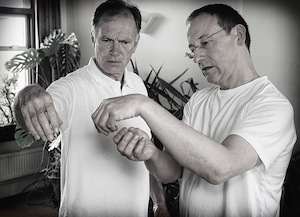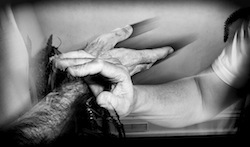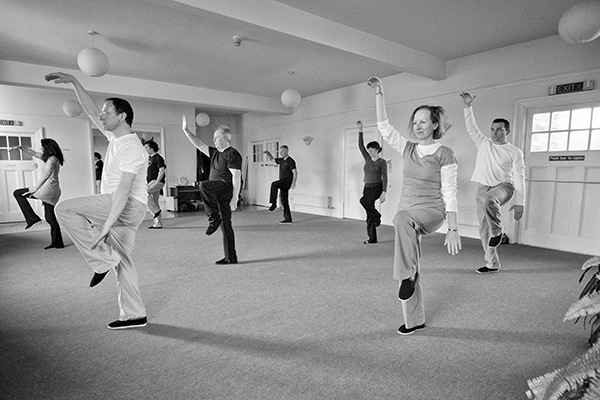Advice for students following their first 18 months training
Origins of the article “Tai Chi: Paths of Development”
This article is based on a number of talks given to students who have started to study the second stage of our t’ai chi syllabus, which focuses more upon the internal aspects of t’ai chi chuan. Students at this stage have typically been studying for about eighteen months, have completed the yang style short form, and have begun the process of coordinating and softening the body and developing internal awareness to the extent where they are more able to relate to internal instruction.
Relaxation and barriers to letting go
Development of perception and insight
Tai chi can be challenging
Many people drop out during the first term or first year of practice as the level of commitment and the deep changes that t’ai chi initiates become apparent. Studying t’ai chi can be challenging on many different levels, and we need a sincere reason to continue, be that the wish to improve a health issue, an awareness that things could somehow be better or we could be happier, or simply a deep fascination.
Relaxation and barriers to letting go
We have already met many of the barriers to our progress during this time, internal as well as external: those internal voices of ego that tell us I’m no good at this, it’s pointless (yes, that is ego also) or that ask Why am I wasting my time on this silly stuff? Learning the personal strategies our minds employ to prevent the challenge of change is an important aspect of our own development. Our minds can be very, very clever and the strategies for self-deception deeply subtle. Yet a part of you – and it’s a very deep part which may not be fully conscious or articulated – has recognised the value of t’ai chi. That’s why you’re still here.
We need to let the structure of our body gently ‘repattern’, to let go of the unhelpful tensions and ways of moving, and to develop a more natural, relaxed way of being. This is why there is such a strong emphasis on ‘relaxation’ in the beginners’ form.
 In my experience of teaching, the desire to learn form quickly – to do push hands and execute martial applications as soon as possible – is actually counterproductive in the long run. If we do this we can simply lay a new pattern of tension over the existing unhelpful habits and spend a lifetime doing more and more, and never letting go, never beginning the process of internal transformation. It’s OK to let go. We have to learn to be happy to accept failures and to ‘invest in loss’ in order to learn and grow as human beings. Again, this process runs so counter to the messages we receive from society that we may be unable to take this difficult path.
In my experience of teaching, the desire to learn form quickly – to do push hands and execute martial applications as soon as possible – is actually counterproductive in the long run. If we do this we can simply lay a new pattern of tension over the existing unhelpful habits and spend a lifetime doing more and more, and never letting go, never beginning the process of internal transformation. It’s OK to let go. We have to learn to be happy to accept failures and to ‘invest in loss’ in order to learn and grow as human beings. Again, this process runs so counter to the messages we receive from society that we may be unable to take this difficult path.
Pushing hands for example has little to do with the hands and nothing to do with pushing with the arms. This is difficult to understand however before the body has begun to soften and integrate to the point where the pathways through the feet, legs, torso and into the arms are directly experienced. Similarly the sword is a great practice for physical health, but it has much more to teach us about developing our shen, intention and moving chi beyond the body. As such we don’t practice everything straight away. We introduce pushing hands and the sword form later in the syllabus at the points where it is most helpful to us.
I use a number of metaphors to describe the process of learning t’ai chi. Initially it’s like learning to drive a car or learning to play a musical instrument, and it’s good to practise a little each day, so that the muscular memory can be reinforced and the neural pathways of the brain – the controlling hardware of our physical mind – can be slowly laid down. It takes time for the form to be internalised and remembered at the body level.
As you relax and your body begins to integrate and move in more coordinated ways, you might find slightly unusual events happening. Even simple everyday occurrences, such as spontaneously catching items which fall when you open a cupboard door, or effortlessly avoiding someone when they are about to bump into you in the street, are a sign that deep change is happening within. These experiences can surprise us and it’s useful to contemplate them and to realise that they are direct result of your practice and a little extraordinary.
In the Daoist t’ai chi and chi gong tradition, there are two common metaphors for the changes you have begun to experience, and I have used them a number of times.
Cooking the body
Practising is a little like cooking food. The food is the body and our own practice is the heat from the oven: as we practise, our body begins to change, soften or cook, from the outside inwards. Our peripheral patterns of tension and movement start to soften and relax; then, as our practice deepens, the more internal aspects of our mind-body begin to transform or ‘cook’.
The process is a little like returning to our ‘centre’, to our ‘source’ or ‘authenticity’, gently letting go of the patterns we have learned and which have successfully protected us in life thus far. The process makes us vulnerable; it is painful to expose and examine those uncomfortable parts of ourselves.
As we release the physical patterning, unhelpful emotional patterns stored in our muscles, facia and posture release. Don’t be surprised therefore if emotions occur during or after practice. Watch them arise and fade away with a detached, observing mind. Sometimes we can cry, sometimes we can laugh. But we always become more alive to the present moment, and that is the priceless gift of our practice – a gift we can carry through life.
The potter’s bowl
The bowl is the external form, and as beautiful as it might be, its true worth and function is in what it is able to contain – in other words, in its internal capacity. T’ai chi and chi gong are magical bowls in that the more perfectly you are able to form the bowl, the more precisely the external elements are synchronised, and the greater the bowl’s internal capacity.
The body is holographic in the sense that even the quality of the little finger can affect the entire energy of the body – that is why I sometimes make what seem to be miniscule changes to the position of your fingers or hands.
As we progress in our practice, our mind becomes quieter, our body softer and our focus deeper, so we are able to connect more with our body and world at the deeper level of direct perception of feeling, and less with the conceptual mind. This is also an indication that our practice is truly deepening and we are beginning the internal journey.
When things fall apart
After a period of practice we might feel that our t’ai chi form has fallen apart, and that our form is worse than when we started! This is actually a sign of progress and of the fact that our understanding has deepened.
The most important personal characteristic needed to follow this path of t’ai chi and personal development is wholehearted sincerity to oneself and, as a direct consequence, to others. With wholehearted sincerity, everything else follows. Conversely, without this quality, progression to higher levels of achievement is difficult.
The internal form
In our lineage, in common with many Daoist teachings, internal information can be presented at three levels: 1) body or jin, which, for example, includes states of muscle tension, quality of ligaments, openness of joints, waves of relaxation or release, etc.; 2) chi, which you now have direct experience of; and 3) shen, which is spirit or heart-mind.
There is also a level of achievement and practice called ‘Natural Way’ a level of practice beyond action and conceptual thought, which Dr Chi Chiang-Tao indicated lay beyond the level of shen.
In actual fact, the levels mix to form the direct experience of our practice. With time, we can choose which level we would like to emphasise, and which is most appropriate on a particular day or at a particular time. It is important to note, however, that practice at the level of jin is fundamental to our development of both chi and shen – and this is the basis from which we start.
Dr Chi Chiang-Tao’s advice was to practise the form three times, the first time concentrating on relaxation, the second on correct technique, and the third relating directly to the experience, which is practising more at the chi and shen levels.
The level of our practice, as well as our specific interest – which may be the cultivation of chi, health or the martial arts – determines the details of our t’ai chi form. This is where very clear instruction is invaluable. It is also important to honestly recognise the level of our own development and to practise in the correct way for that level of achievement – and that is why finding a teacher you can trust to guide you is so important.
Development of perception and insight
Understanding occurs at deeper and deeper layers as time passes. My principal teacher, Alan Peck, spent over ten years practising the information transmitted to him by Dr Chi Chiang-Tao in a relatively short period of time. I heard him say on various occasions in the years following his study with Dr Chi that this particular aspect of practice was only now beginning to make sense and only now was he reaching a certain level of achievement (for example ‘body fully as one unit’, or ‘permanently sunk’). My experience has been similar, and when revisiting the classic t’ai chi texts a number of times over the decades, each time my understanding has been deeper from the experience of practice.
Deep understanding – understanding originating from a direct connection with feeling, as opposed to thought or concepts – depends upon the gradual changes that practice brings to both body and mind. If you do think you understand, you should also accept that your understanding will change as your body and mind changes over time, and you should be willing to let go of what you thought you knew.
 If you don’t understand something, and you don’t understand the explanation, just tuck it away in the back of your mind. If you continue to practise with sincerity, at some point, and if it is relevant to you, you will understand and the information will be available to you – even many years after.
If you don’t understand something, and you don’t understand the explanation, just tuck it away in the back of your mind. If you continue to practise with sincerity, at some point, and if it is relevant to you, you will understand and the information will be available to you – even many years after.
With correct practice we start to have a clearer perception of our own problems, which manifest as health, mental or energy-related issues. Indeed, we usually become aware of problems of which we were once oblivious – and that is actually the first step to being able to practise to reduce or even eliminate them. If you are not aware of a problem, you can’t begin to resolve it. My experience is that becoming aware of my own personal issues has always been a gateway for positive change.
The result of our practice can be a more profound state of health than that usually considered as ‘being healthy’ by Western medical understanding. Conditions once tolerable become intolerable, and this may lead to profound dissatisfaction and changes in the way you lead your life. The path of change and development is not always easy.
Working with people
A consequence of working deeply with yourself in this way and becoming aware of your own subtle problems is that you correspondingly become aware of health problems with friends, family or even strangers you pass on the street, even when they are not aware of these problems themselves. It’s possible to feel sadness for our own problems and a great empathy at the high level of dysfunction and illness in many of our fellow human beings.
However, it’s not appropriate to offer uninvited advice. This could be ego-driven; it is invasive and mostly not appreciated. Rather, continue to work deeply with your own issues. You will most deeply help people by being ‘who you are’ and what you are able to achieve – not by ‘what you say’. As your shen develops, and if you allow it to express itself, people will naturally approach you – and at that stage people will be empowered to find their own path to change.
Partner work in t’ai chi develops our perception, including certain ‘intrinsic energies’ such as our ‘joining’ and ‘sticking’. We learn to more deeply understand balance, sinking (as opposed to physically lowering the body), integrating the body, fullness and emptiness. By practising together, we not only begin to understand the martial aspects of the art, but more importantly can help each other progress to higher levels of achievement.
With practice comes a degree of direct insight (as opposed to conceptual understanding), and then there can arise a sort of ‘internal certainty’ that you have a unique understanding, which is highly significant and very important. Your peers may be having exactly the same thoughts! Examine this state of mind in great detail. Beware, as our minds can be very clever, and the more intelligent you are, the more your potential for self-delusion. Use this intelligence to examine your own mind. Feelings of absolute certainty could simply be the mind deluding itself and preventing further development. Thoughts which compare yourself with other people distract you from your own practice.
Rather, remain playful, as inquisitive as a child, and approach your practice with an open mind. Concentrate on your own practice but be willing to learn and play with everyone.
Development of chi
The development of our connection with chi has preventative and protective qualities. We may naturally change our diet or other unhelpful habits to protect our health for example. More broadly, we can also become more sensitive to people and ‘street energies’ and have a greater potential to avoid trouble even before it begins to develop. Our ability to connect with chi and the development of subtle perception are intimately related.
The popular Buddhist text the Dhammapada relates that ‘all things are created by mind and are led by mind’. This understanding guides us directly towards the essence of chi, a phenomenon that is close to but a little more subtle than physical phenomena. The consequence is an understanding that chi can exhibit characteristics that are determined directly by our minds and, as our minds can be quite different in their qualities. Chi can manifest with different, even apparently contradictory, qualities for different people.
Chi is ‘created and led by the mind’, and as such its essence is only limited by your level of practice, understanding and imagination. This quality of chi leads to all sorts of fun and games, arguments (I’m right, you’re wrong), and whole industries of different therapies, different approaches and different schools of practice, each with their own certainty that they hold the ‘real truth’ or the ‘complete system’. Beware of this trap. Absolute certainty in a system, although very appealing when you are looking for a clear path, can be bad news and the red warning light should start to flash. Such a rigid attitude is not helpful to the full exploration of your own truth and it will limit you in some way. The Daoist ‘five-word secret’ – ‘if you think there is a technique, that is not it’ – was one of Alan’s favourite quotes.
T’ai chi and Daoism
T’ai chi and qi gong is a study of Daoist philosophy with both the body and the mind. In Daoism the wisdom derived from practice – and the direct perception of the body – is at a far, far deeper level than intellectual understanding. Daoism cannot be fully understood by intellect alone.
The idea of a ‘path’ or ‘way of being’ which is in harmony with nature and the universe is central to Daoism. This is called the dao. If one’s actions in life are harmonious and flow with the dao, then one becomes effective in the world with little effort. Indeed, the highest level of achievement is ‘action’ through ‘non-action’, which is called ‘wu wei’. The twist to this story, however, is that aligning oneself fully with the dao usually takes significant effort and possibly a lifetime of practice!
Another aspect of Daoism – possibly the most widely known in the West – is the philosophy of opposite energies and their dynamic interplay, depicted by the yin/yang symbol. When we practise the internal aspects of t’ai chi we begin to study these fundamental wu, yin and yang aspects of the universe and their interplay – mirrored as a microcosm within our body and being.
Letting go of technique
In our school one practises and masters technique to achieve an effect, and that takes significant effort. We practise to relate fully and wholly to the effect, letting go of any technique. At this point, relating to the effect becomes the technique for further progress – that is, one practises with the direct feeling of the effect in order to develop the effect. Clinging to technique at this stage inhibits any further progress to higher levels of achievement.
As a specific example, we may relax the complex layers of muscle around the shoulders, articulate the shoulders and extend the deep muscles near the spine; relax the biceps; and extend the triceps to open the elbow joint. We may then extend the medial and relax the lateral aspect of the wrist joint, subsequently opening and extending all the small muscles in the palm and fingers that bind the metacarpals and phalanges. This has the energetic consequence of leading chi strongly to the fingertips and beyond.
After the arm, hand and fingers have been opened in this manner, we spend time in the exercise recognising the effect that it has upon our body feeling. After the exercise it is important to reflect and recall the feeling.
With time and practice, as the quality of our body changes, it becomes sufficient to recall the resultant feeling to invoke the energy whenever we wish within the t’ai chi form. Indeed, sticking rigidly to physical technique (jin level) at this stage impedes further development at the chi level by imposing a limiting, if unconventional, structuring upon the body. As the saying goes, ‘when you have crossed a river, there is no longer any need to carry the boat’.
T’ai chi and Buddhism
In terms of the relationship between t’ai chi and Buddhist practice, achievement of the state of ‘natural way’ in Daoism may be considered to be similar to the state of resting in ‘natural ease’, a state of non-thought and non-action. Termed ‘Dzogpa Chenpo’, this system was expounded by the Buddha in his later teachings and it is regarded by some as the highest of the nine vehicles or ‘Yana’ of Buddhist teachings.
The method of ‘relating to the effect’ that we discussed earlier can be considered similar to a ‘skillful method’ within Vajrayana Buddhism, where ‘the result is taken as the method’, or ‘the fruit is the path’. Unpacking these statements a little, we mean that the method of achieving the result is to identify completely and sincerely with the final result.
Thus in our t’ai chi, after some years of study, we might practise as if we already were a high-level t’ai chi master, whereas in the Vajrayana Buddhist context we might identify completely with a highly realised ‘being’ as the path to achieving mental and spiritual transformation. This skillful method is termed ‘change of identification’.
Although a powerful technique for transformation, the scope for significant mental delusion is very real, and Buddhist teachings warn of the pitfalls that can occur with this method without a very solid basis of transmission, practice and achievement.
In the t’ai chi tradition, our degree of self-delusion can be tested whenever we practise with a partner! This can rapidly bring us back to reality. If you can’t do it, you don’t understand it and you are not as advanced in your practice as you think! It is one of the reasons why correct partner work (work where the partner isn’t always compliant) is absolutely central to our progress and why we place a lot of emphasis on it. There is simply little scope for self-delusion. It brings us back down to earth.
In summary
So here I have outlined the next stage in our t’ai chi studies and sketched out how the path stretches out before us: specifically, how we practise, why we practise in a particular way at particular stages of our progress, common barriers to progress and ultimately where the practice could lead. I have outlined how this path relates to both Daoist and Buddhist systems of thought.
We have already started to develop some of the intrinsic energies of t’ai chi, and we will practise and discuss these in much more detail in the future. Using a sci-fi metaphor from The Matrix, we have already swallowed the red pill and are beginning to look beneath the surface and understand ourselves, and as a consequence others, in unconventional ways.
Author: Tim Parsons
Images: Taiji-Forum
Tim Parsons studied tai chi with Alan Peck for twenty two years before Alan’s death in 2010. Alan Peck’s advanced notes on Natural Way T’ai Chi are available for the Kindle via Amazon or in PDF form by contacting Tim at: naturalwaytaichi@gmail.com.

